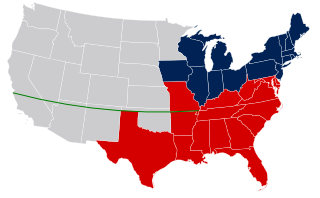Forty years before the United States erupted in Civil War, the debate over slavery kicked into high gear with the passage of the first Missouri Compromise on February 17, 1819. Designed to create a plan for the admission of new states into the Union with a balance between pro- and anti-slavery, the bill made it through the House of Representatives before being denied by the Senate. The US was well on its way to becoming a house divided. Missouri Territory first petitioned Congress for the ability to join the nation in 1817. According to American law, potential new states presented plans for a constitution and an overarching structure for government within the boundaries described. Halfway through the House of Representatives 1818-19 session, the request was pushed into a Committee of the Whole on February 13, 1819, a special meeting in which the entire legislature gathered for discussion on its merits before a floor vote. Representatives from slave-owning states were wary of the bill. When the application was received, there were 11 free states and 10 slave states, meaning the acceptance of Missouri as the former could provide an even larger majority. If, on the other hand, residents in Missouri opted to welcome slavery, it would bring parity to votes about the future of forced labor in the young nation. As with any resolution presented to either the House or Senate, the bill was subject to additions and subtractions by committee members. Specific portions of the proposal are frequently altered to reflect ideological or political preferences, similar to the spending “earmarks” American politicians lament during campaign season today. James Tallmadge, a representative from New York, proposed an amendment bearing his name that prohibited importing more slaves into Missouri and guaranteed freedom to those born into slavery after admission upon reaching the age of 25. The day after a rousing speech from Tallmadge, the measure gained steam thanks to a larger proportion of Northern politicians in the House. The first Missouri Compromise was authorized on February 17, 1819, and, following constitutional procedure, the resolution then passed to the Senate for final ratification as federal law. With both sides evenly represented in the higher chamber of the American legislature, the bill failed and Congress adjourned with Missouri’s future unsettled. At the start of the 1819-20 Congressional session, three applications for statehood were on the line: Alabama, Maine and Missouri again. Being deep in the slave-holding South, Alabama gained relatively quick entry and balanced the 22-state nation with 11 pro- and anti-slavery states each. With the Senate considering the petition from Maine, a free state, Jesse B. Thomas of Illinois attached an amendment allowing Missouri to enter as a slave state. In addition, a line along its southern border would be used to determine the status of territories seeking statehood in the future — anything below would allow slavery. Driven by the political skill of Senator Henry Clay of Kentucky, the Missouri Compromise finally passed on March 3, 1820 over the objections of states-rights activists. For more than 30 years, the law managed to hold the Union together as adventurous Americans pushed westward into the frontier. With the passage of the Kansas-Nebraska Act of 1854, which guaranteed citizens the right to vote on whether a state should be free or not, and the Supreme Court decision in Dred Scott v. John. F.A. Sandford (1857) making slavery constitutional throughout the nation, the Missouri Compromise became obsolete. Tensions quickly elevated as the slavery question was debated in new territories — and the US rolled toward the Civil War. Also On This Day: 1600 – Philosopher Giordano Bruno is burned alive for heresy at Campo de Fiori in Rome 1864 – The H.L. Hunley becomes the first submarine to sink a warship, the USS Housatonic 1904 – Madama Butterfly premieres at Milan’s La Scala opera house 1972 – The Volkswagen Beetle surpasses the Ford Model T as the most-manufactured car of all time 1980 – Krzysztof Wielicki and Leszek Cichi complete the first Winter Ascent of Mt. Everest You may also like : February 17 1600 – Philosopher Giordano Bruno is burned alive for heresy at Campo de Fiori in Rome
February 17 1819 – The First Missouri Compromise Passes the United States House of Representatives
Forty years before the United States erupted in Civil War, the debate over slavery kicked into high gear with the passage of the first Missouri Compromise on February 17, 1819.…
259
